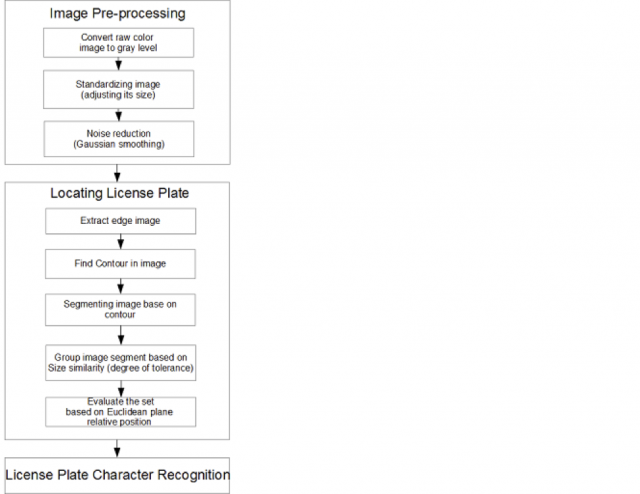Fast Performance Indonesian Automated License Plate Recognition Algorithm Using Interconnected Image Segmentation
Samuel Mahatmaputra Tedjojuwono
A reliable and fast algorithm is needed to implement a License Plate Recognition in a real life vehicle traffic environment. This paper proposed a hybrid algorithm of interconnected image segmentation and contour extraction to locate and identify license plate for a given image. A pre-processed image will be segmented in several small images based on contour detection algo- rithm. The location of each segmented image’s centre was then plotted into a Euclidean plane to get their relative positions. The distance and position of the segments evaluated in search of interconnected segments. This set of segments then will be fed into a cost function that determines its level of relevancy as a plate number. Set with highest score went through character recognition process to extract the meaning. Proposed work was tested in Indonesian license plate system with a high rate of correctness and average processing speed of 100 mil- lisecond.
The use of Automatic License Plate Recognition (ALPR) in real live environment is very much increasing in need. This is supported by a study in its usage for the secu- rity, surveillance and law enforcement system [1]. The study showed that although it is considerably expensive, ALPR may increase the traffic surveillance system produc- tivity. Moreover, to perform in real live situation the system should incorporate two major characteristics which are fast and precision. These characteristics are very much the centre of discussion in all works and researches in improving ALPR system. This paper will focus on the first part of that characteristic without neglecting its ac- curacy level as well. An agile and fast performance recognition system is proposed using interconnected image segmentation of image features extraction technique. The system was tested in particular for major Indonesian license plate system whereas it is a one-line horizontal plate with white digit color and black background. The result of proposed algorithm showed promising outcomes in term of processing time (efficien- cy) with reasonable detection accuracy. Apart from its fast and precision performance, the proposed system needs to work under certain reasonable condition such as light and camera position with properly applied parameters’ values.
The proposed algorithm is divided into three main parts: (i) Image preprocessing (ii) License plate localization (iii) License plate character recognition. The detail block diagram can be seen at Figure 1. To achieve both reliable and fast ALPR sys- tem performance, the system used a preprocessed image as an input. Embedded to the system is an image preprocessing modules that converts raw color image to a gray level image. A smoothing processed then applied to the image using Gaussian tech- nique in order to minimize noise.

The preprocessed image will then fed into the license plate localization process. This process will segments the image I into several small images Ii based on the find- ings of contours ci. However, to extract contours ci from the image, edge detection was first applied using canny edge detection technique. A certain ratio evaluation of ci width and height r(w:h)i is needed to determine whether the Ii is a possible license plate number or not. Ii with certain degree of ri similarity will then are grouped to- gether in one set Sj.
The algorithm of interconnected segmentation forming the set Sj is described by the following pseudo-code:
function interconSegment (image[ ] Segments) {
set image iSegment[ ]
set image neighbors[ ]
set decimal tolerateDeviation
for each image in Segments {
for each image in Neighbors {
If Segments[i].height == neighbors[j].height
& Segments[i].width == neighbors[j].width
& Segments[i].height/Segments[i].width==tolerateDeviation
{
add Image to iSegment;
}
} }
return iSegment[] }
The proposed work presents a fast performance license plate localization that was tested on 100 samples of Indonesian license plate system taken from various indoor and outdoor conditions both day and night. The result of the proposed algo- rithms was promising as the average time for a complete ALPR process of image pre- processing, license plate localization, and character recognition took 100 millisecond in average. The accuracy of localization process was 97% whereas the character rec- ognition came up with 85% accuracy.
Moreover, in the future the work still needs to be equipped with transformation process as to deal with tilted license plate images as a result of a poor camera posi- tioning. The algorithms also will incorporate filtering techniques to suppress the or- nament problem previously described. Methods and algorithms will be designed and implemented carefully as to maintain the fast performance of the proposed system. Future work would also compare – perceived to be the most time consuming – process of license plate character recognition with the other part of ALPR system: (i) Image preprocessing (ii) License plate localization.
Please read the following paper for full detail:
https://link.springer.com/chapter/10.1007/978-3-662-46742-8_27

